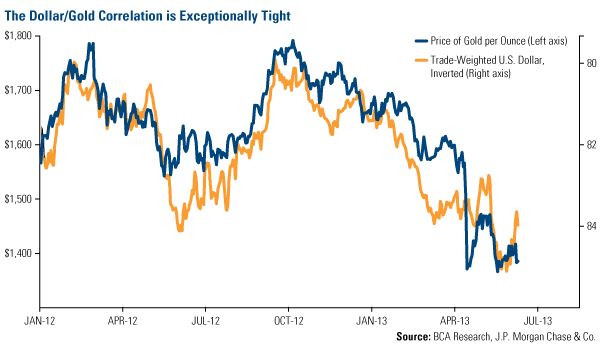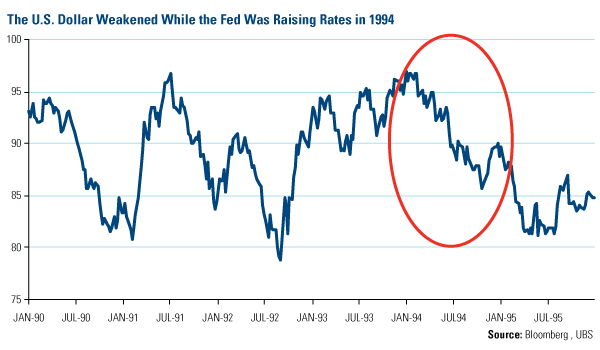Gold Market Radar
For the week, spot gold closed at $1,390.74, up $7.69 per ounce, or 0.56 percent. Gold stocks, as measured by the NYSE Arca Gold Miners Index, lost 3.12 percent. The U.S. Trade-Weighted Dollar Index lost 1.22 percent for the week.
Strengths
- The negative correlation between the U.S. dollar and gold has increased dramatically as of late, giving analysts one more tool to consider when looking at the price of gold. As the chart shows, the trade-weighted dollar has weakened significantly over the last few days, mainly due to a lower pace of monetary easing by the Bank of Japan and the European Central Bank, and the resulting strengthening of the Japanese yen and the euro. The dollar weakness should bode well for higher gold prices.
- Klondex Mines reported metallurgical sampling results for May with an average diluted grade of 74 grams per ton. The high grade of the material allows for it to be direct smelted, which leads to typical recoveries in the high 90 percent range. As a result, Klondex has the potential to generate meaningful near-term revenue, according to Michael Dilay of Casimir Capital. On the same note, Torex Gold announced it has received final approval of its Environmental Impact Assessment for its Morelos project in Mexico. The company expects to begin construction as early as July of this year, which significantly de-risks its Morelos project and the overall valuation of the company.
- Over the past two years, Eldorado Gold is the best performer in the NYSE Arca Gold Bugs Index (HUI), which highlights the importance of overweighting the low-cost producers, and ensuring they can grow sustainably throughout the commodity cycle. Alamos Gold is not a component of the HUI Index, but it also compares favorably; it has a low-cost profile, is growing its production per share, paying a dividend, and repurchasing stock. See our CIO Frank Holmes’ Three Reasons to Buy Gold Equities Today and a Case Study on Alamos Gold.
Weaknesses
- Nouriel Roubini published another article this week in which he continued to refer to gold’s run up to $1,900 per ounce as a bubble, and gives his opinion as to why the bubble has burst. Thanks to Chris Kwan at BMO, we were directed to comments from George Milling-Stanley – a former member of the World Gold Council – that refute Mr. Roubini’s claims. According to Milling-Stanley, a study from the World Gold Council titled “The 10-Year Gold Bull Market in Perspective,” dated September 17, 2010, demonstrated conclusively that trends in the gold price during this bull market had nothing in common with four acknowledged bubbles: gold in the 1970s, Japanese equities in the 1980s, tech stocks in the run-up to 2000, and real estate prices in the period preceding the crash in 2007.
- Not only has Newcrest Mining delivered news of a $6 billion write-down in asset values, Mineweb reports the Australian Securities Exchange (ASX) has questioned Newcrest over the timing of the profit warning, which was issued after several brokers had revised down their forecasts for the company, raising concerns in the market that some analysts had been briefed ahead of time. Newcrest Mining has responded to the inquiry by denying any wrong-doing.
- Kinross Gold announced it will abandon the development of its Fruta del Norte deposit in Ecuador, given the inability to negotiate suitable investment terms with the government. The government indicated it is not willing to continue the negotiation further, nor offer a sale of the asset to a prospective developer. The company has indicated it will take a $720 million charge in the second quarter of 2013, of which $20 million will be for cash severance and closure costs.
Opportunities
- The assumption on the street is that once the Fed starts tapering its QE program, the dollar will strengthen as real rates head up. Julien Garran, in his UBS Commodities and Mining Q&A, provided some insight into what really happened to the U.S. dollar in 1994, the last time we were in a similar situation. Back then, as the Fed hiked interest rates and real yields increased, the dollar should have rallied, but it fell instead and gave a boost to commodity prices. The reason was that despite a stronger-than-expected U.S. recovery, the European recovery surprised analysts, which triggered a currency move, thus selling off the dollar. This is particularly interesting today, as the ECB announced it would refrain from further monetary easing until further notice, a policy that surprised investors and led to a strengthening euro and weakening dollar this week.
- On the same subject, the dollar continues to face the threat of negative real interest yields. Despite the assertion that real rates will continue to rise, we are of the opinion that the Fed is unlikely to allow further increases in government yields. The fiscal deficit needs to be financed, and the government cannot afford to refinance at higher yields than those of today. In addition, the natural trend of inflation will eventually force CPI numbers to escalate, which, rather than resulting in increasing real rates, would have the opposite effect of lowering real rates. This outcome should bode well for the commodities complex overall, but more strongly for gold, whose negative correlation with the dollar has been strengthening as of late.
- Pretium Resources released its Feasibility Study this week, confirming probable reserves of 6.6 million ounces at an average grate of 13.6 grams per ton. The valuation metrics look very positive, to the point where some analysts on the street are calling it “one of the best, if not the best, undeveloped gold project out there.” The next milestone will be details of the bulk sample which is expected in the fourth quarter of this year. This success validates our investment theory of supporting companies led by top managers, and developing rich resource bases.
Threats
- Paradigm Capital published a study on gold explorers and their expected lifetime based on their cash levels and current burn rates. On average, the companies studied have one year of cash burn remaining, something that has been worrying investors, given that a situation in which markets fail to improve, will see many of the explorers go dormant, bankrupt or be consolidated. However, Paradigm believes the sector will come back to life even if gold prices stabilize because the industry will adapt and reduce costs, signs of which should emerge fairly soon.
- On Ernst & Young’s “Business risks facing mining and metals 2013-2014” report, the company reports on a trend that has been evident on the stock pricing in the sector over the last few months: investors are pulling back from risky investments, namely junior explorers and developers. Instead, investors are seeking high-yielding, near-term opportunities, a style that has not favored gold mining stocks over the years. Fortunately, we have followed a dividend income approach over the years, which has helped avoid many of the extraordinary risks in the sector.
- A new amendment act has introduced a number of significant changes to South Africa’s mineral regulatory regime. The changes, signed into law by President Jacob Zuma, allow the Mines Minister to impose stricter conditions on mining rights where the land is occupied, which may go beyond the requirements of the Mining Charter. There could be further compliance and regulatory costs on the industry, according to Johannesburg-based law firm Webber Wentzel.














